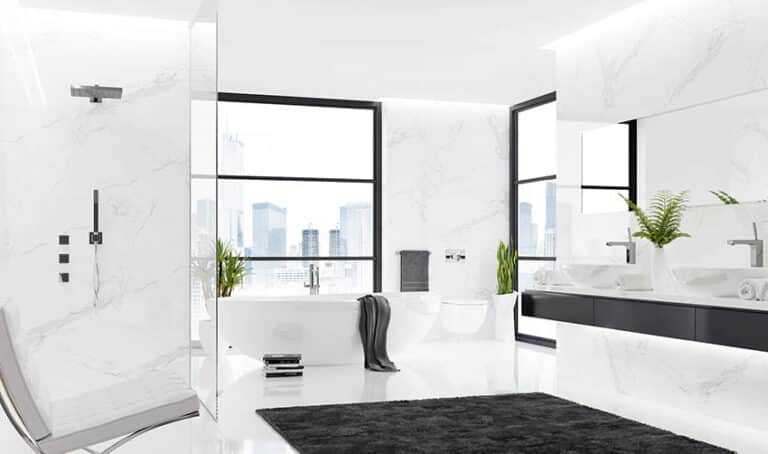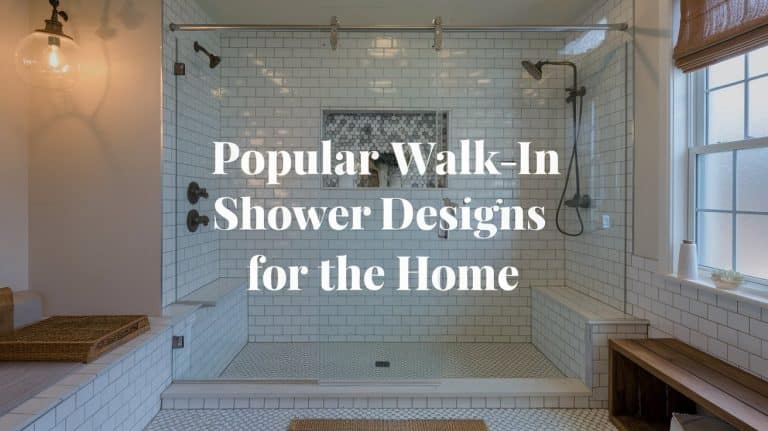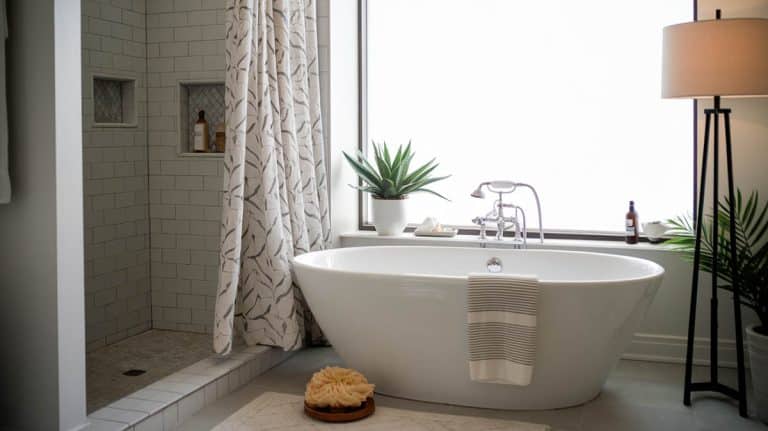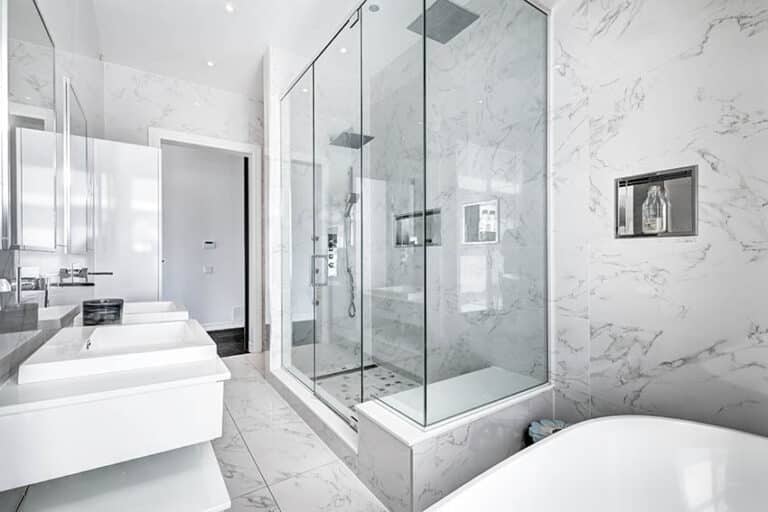Acrylic Vs Fiberglass Tub (Pros & Cons)

When you’re renovating your bathroom, a new tub not only gives the room a new look but also provides plenty of long-term benefits when you choose the right tub for your wants and needs. As with many renovations, though, you have a lot of options when it comes to different tub materials.
Here, we’ll take a moment to break down everything you need to know about two of the most common bathtub material options – acrylic and fiberglass – and how they measure up when compared.
What Is An Acrylic Bathtub?
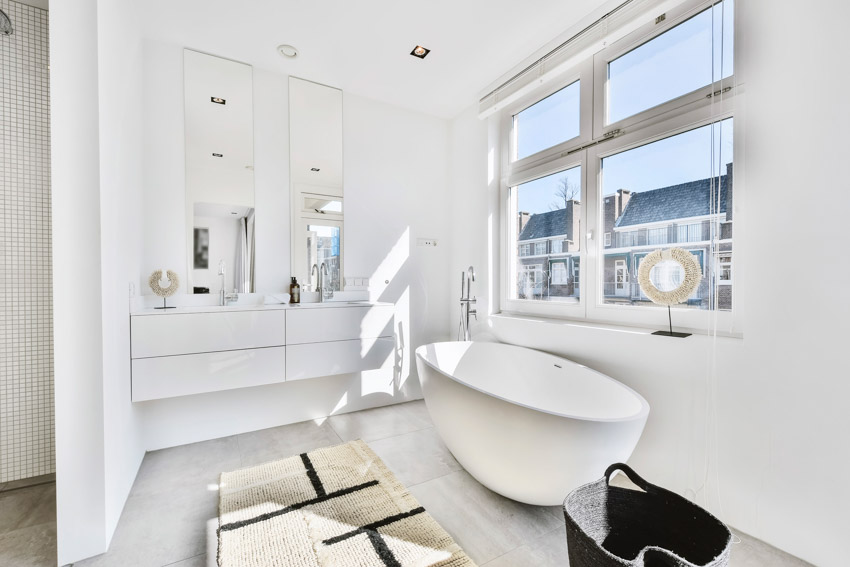
Acrylic bathtubs are an affordable and lightweight tub material option that offers plenty of benefits. This type of tub is made of acrylic and formed into sheets using vacuum technology.
Interestingly enough, given the comparison in this guide, some acrylic bathtubs even add a bit of fiberglass to the equation to add a bit of added reinforcement.
Overall, acrylic is a versatile material that you can find in a variety of bathtub dimensions, shapes, and colors as well. This means that you can find a variety of tub options to fit your bathroom.
Acrylic Bathtub Pros And Cons
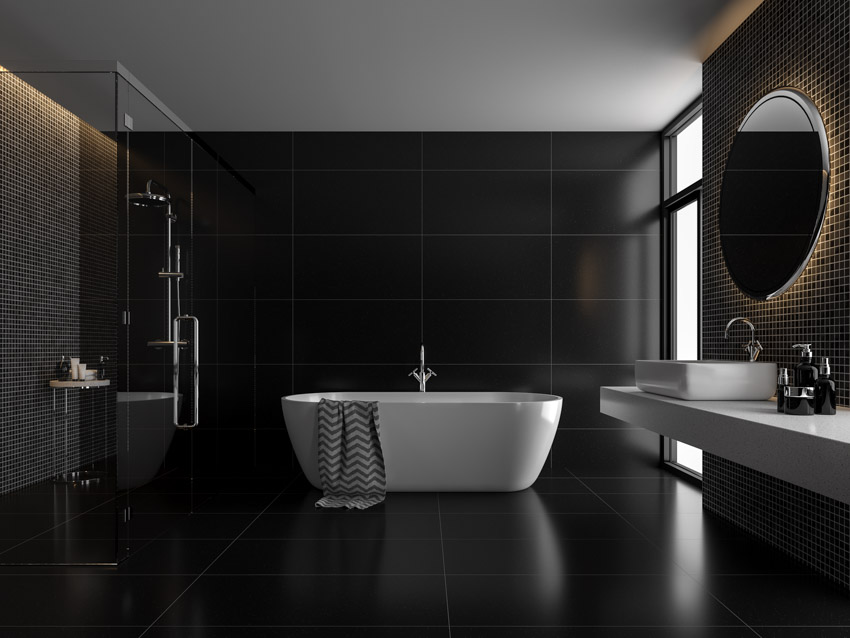
Before moving on to fiberglass tubs, let’s take a moment to look at some of the benefits and drawbacks that you can expect if you opt for an acrylic tub.
The pros of acrylic tubs:
Durable – One big benefit is that acrylic is hard to damage. It’s not very likely to chip or crack, but if something does happen, you can likely repair it with a kit rather than worry about permanent marks or replacing the tub.
Easy to Clean & Maintain – This durability can only go so far without proper maintenance. The good news is that cleaning your acrylic tub should be a breeze.
You’ll just want to ensure you don’t use abrasive sponges, clothes, or chemicals that could potentially damage the acrylic.
Heat Retention – A benefit that’s particularly great about acrylic in a bathtub is that it retains heat. That means it won’t get quite as cold as the best bathroom countertops made of marble or tile flooring, for example.
Many Design Options – When it comes to designing your bathroom, you can rely on acrylic options to give you a lot of versatility when it comes to choosing options like tub style and color, too.
The cons of acrylic tubs:
The Look – However, some people do dislike the plastic-like appearance that acrylic tubs have unlike options like ceramic or marble.
Sensitive to Certain Cleaning Products – Abrasive cleaning products can stain and scratch an acrylic tub. Care must be taken to ensure nothing is used that can cause damage to the surface areas.
What Is A Fiberglass Bathtub?

Fiberglass is a type of reinforced plastic that has a lot of similarities to acrylic but enough key differences that they’re worth highlighting. We’ll get into that a bit more in a moment but for now, let’s look at what a fiberglass bathtub is.
Fiberglass tubs are made with layers of materials. These layers are fitted together and heated until they fuse. While they’re heated, the fiberglass can also be molded to fit a variety of tub designs.
Fiberglass Bathtub Pros And Cons
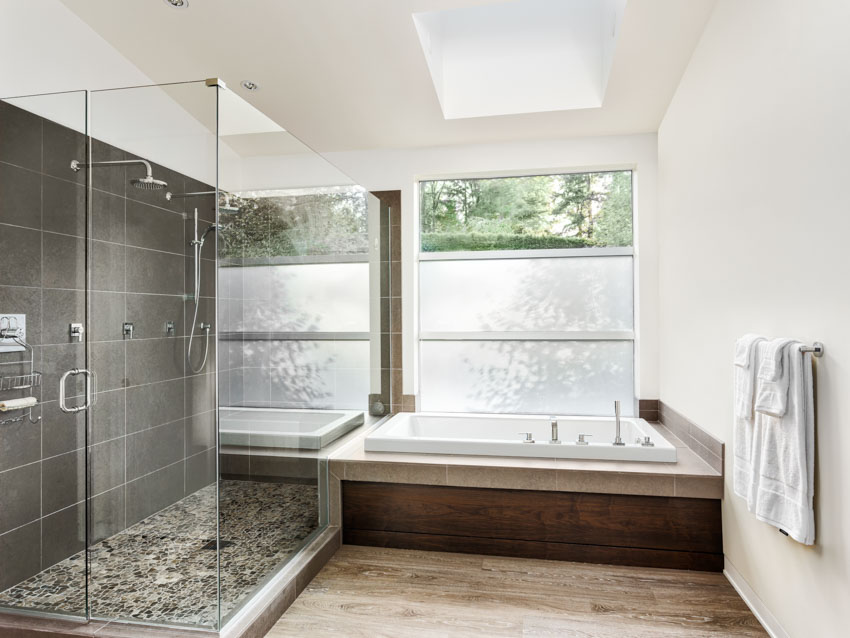
Just like acrylic tubs, fiberglass bathtubs come with their own pros and cons to consider before making your final decision.
The pros of fiberglass tubs:
Affordable – A fiberglass tub is one of the most affordable options and has a main advantage over other types of tubs. Fiberglass models generally cost less to buy than acrylic, epoxy resin, stone materials, cast iron and copper tubs.
Lightweight – Some of the pros of fiberglass are similar to those of acrylic. For instance, it’s a relatively lightweight material that isn’t as hard to install as some other bathtub material options. This makes it a particularly good option if you’re looking for a suitable option for a tub that’s on an upper floor of the house.
Easy to Repair – Another similarity the two share is that fiberglass is also easy to repair if you notice a scratch or crack. The only drawback is that this is because the fiberglass is softer, meaning it will also scratch and crack easier than a material like acrylic.
The cons of fiberglass tubs:
Not as Durable – Fiberglass is a porous material, so if the protective top layer wears over time, you’re going to have to contend with water damage and even warping.
There are also some durability issues when it comes to fiberglass bathtubs. As we just mentioned, this is in part because the material is soft.
Can be Damaged More Easily – On top of that, fiberglass is a rather thin material compared to other common tub materials, making it more susceptible to damage.
Can Fade Over Time – Finally, while your fiberglass bathtub will last up to 15 years, you might notice the color fading over time. This is because the color in fiberglass doesn’t always permeate all the way through the layers that make up the material, making them more susceptible to fading over time especially when subjected to direct sunlight.
Tub Cost
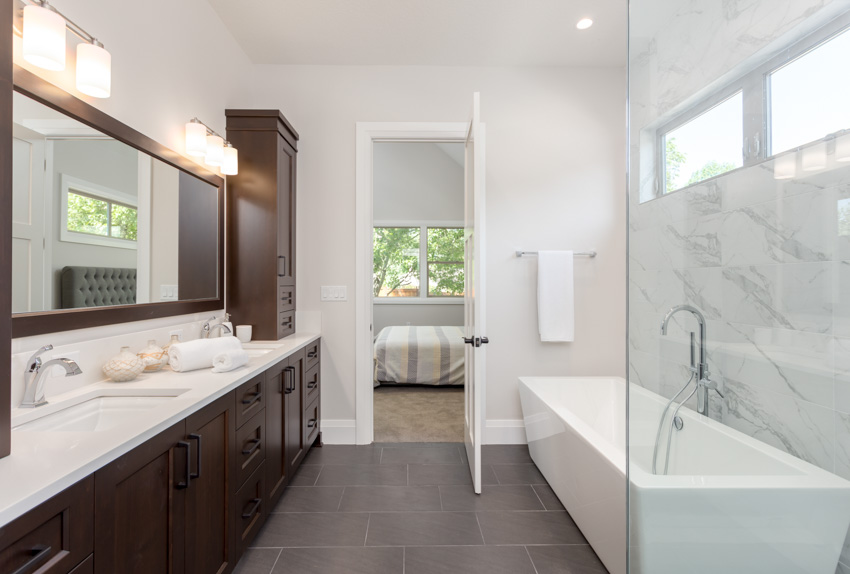
When you’re considering a renovation in your home, it’s important to consider the cost of the project. As such, it only makes sense that the cost of these two options is an important factor in comparing them to one another.
Naturally, the exact cost of the tub will depend on factors such as the size and design you choose. The average acrylic tub costs around $500. Yet, if you’re looking for something a little cheaper, you can find budget options with options as low as $250.
On the other hand, if you want to go all in with a luxury acrylic tub, you can expect to invest closer to $900.
Regarding acrylic vs fiberglass tub cost, the latter can save a bit on renovation costs. You can expect a fiberglass tub to run an average range of $200 to $800. As with acrylic tubs, this varies depending on the specific features of the tub you install.
Durability
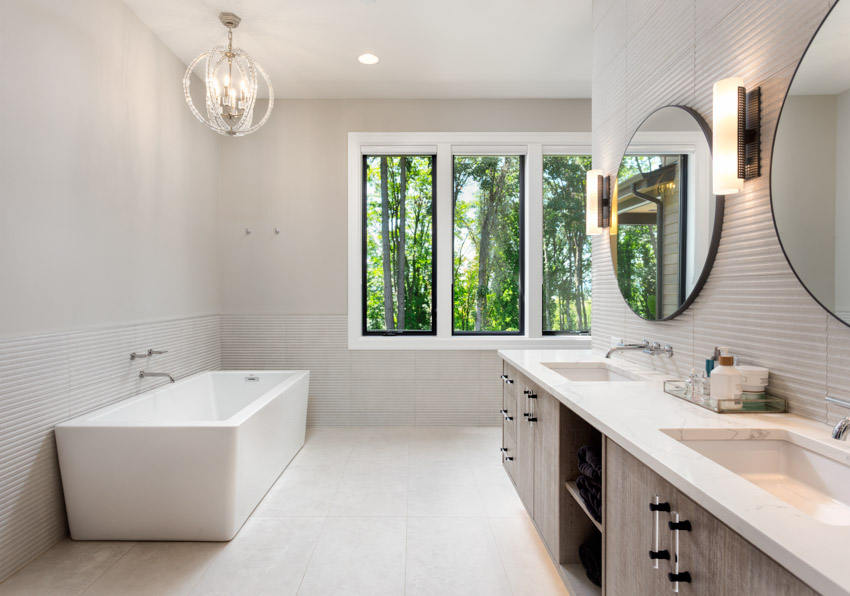
When you’re seriously entertaining different bathroom remodel ideas, you probably don’t want to have to commit to the renovation again anytime soon. As such, it’s worth considering how acrylic tubs and fiberglass tubs compare when it comes to durability.
This is an area where acrylic tubs win out over fiberglass tubs. While both are durable, fiberglass has a few durability issues that can be a cause of concern for homeowners.
On the surface, you’re more likely to notice fading on a fiberglass tub than on an acrylic tub. In addition, acrylic tubs are non-porous and don’t have the same problems that fiberglass tubs do when their finishing coats wear off.
Without the need for this finishing coat to make the surface non-porous, acrylic isn’t as prone to water damage which is a great feature for a bathtub that you want to last quite a while.
Lifespan
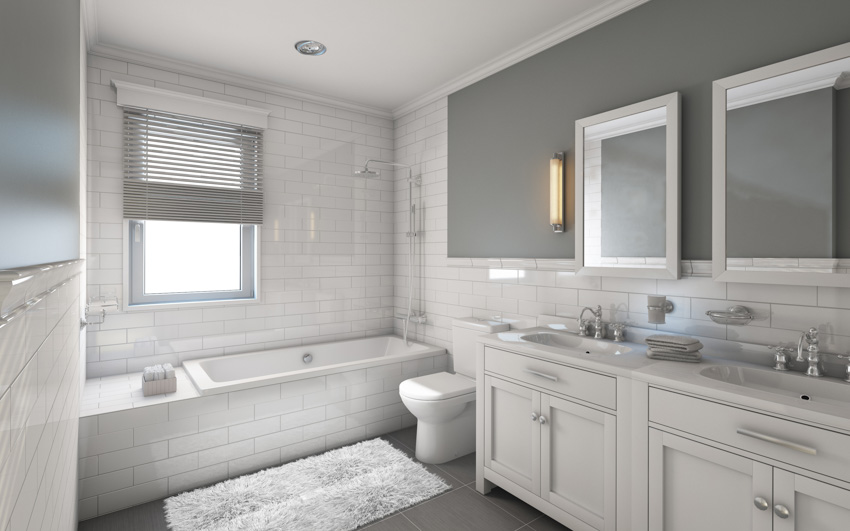
Now that we’ve discussed durability, it’s worth taking a closer look at the bigger picture. Given that a tub is maintained as well as possible and doesn’t incur any excessive damage, how long will an acrylic tub or a fiberglass tub last you before it reaches the end of its lifespan?
The good news is that on this front, without any superfluous damage, both types of tubs are going to last about the same time. Both acrylic and fiberglass bathtubs are expected to last an average of 10 to 15 years.
Naturally, you’ll want to keep the points about the durability of these two types of tubs in mind here. Given that acrylic is generally more durable, you will run into fewer challenges that could cut the tub’s lifespan short compared to fiberglass tubs.
How To Tell The Difference Between Fiberglass And Acrylic Tubs

If an acrylic tub or fiberglass tub is already installed, there are certain ways that you can tell the two apart.
First, take a look at the thickness of the material – you might be able to see this most clearly at the lip of your tub. Fiberglass is slightly thicker than acrylic, so a thicker lip will lean more towards an acrylic conclusion.
Another less surefire way to tell is to consider the color of the tub. While both come in a variety of colors, acrylic isn’t nearly as limited in colors as fiberglass.
Fiberglass tubs are most commonly installed as plain white tubs, so if you see a uniquely-colored bathtub, it’s more likely that it’s acrylic, although this method is naturally less surefire.
If you know the weight of the tub, that can help, too. The average fiberglass tub is only about 70 pounds, while acrylic tubs are still lightweight but slightly heavier than fiberglass at about 100 pounds on average.
Which Is Better: Acrylic Or Fiberglass Tubs?
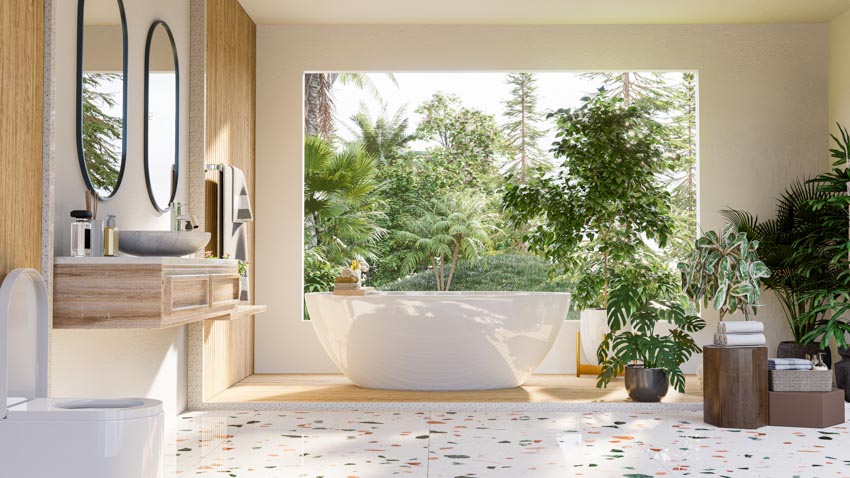
Both of these materials offer a lot to homeowners who are interested in a lightweight and affordable option. However, we are here to determine the differences between the two materials and decide which one reigns supreme.
So, all of this comes down to one big question: between these two options, is it better to go for acrylic or fiberglass? At the end of the day, acrylic bathtubs tend to win out for a few reasons.
While both options have similar lifespans, the durability of an acrylic tub wins out over fiberglass. While fiberglass is brittle and prone to cracking, acrylic isn’t quite as brittle and is a little less likely to incur impact damage or weight damage.
Aesthetically, acrylic pulls ahead as well. Not only are you likely to find more color options in acrylic but it isn’t as likely to fade over the years as a fiberglass tub is.
See more related content in our article about how to turn a shower into a bathtub on this page.

